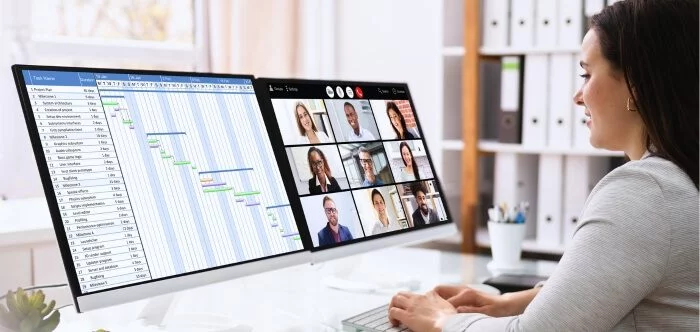A conference agenda is more than a simple schedule; it’s the roadmap to a successful event. The pivotal question, “What is the agenda of a conference?” finds its answer in the essence of this crucial tool.
A conference agenda serves as a comprehensive guide detailing the various activities and sessions planned for the event. It offers attendees, organizers, and speakers a clear, structured overview of the event, enabling them to identify and prioritize the presentations, breakout sessions, and networking opportunities that align best with their interests and goals.
This focused approach boosts the overall experience and ensures effective time management. To dive deeper into how a well-crafted conference agenda can transform your event experience, continue reading as we explore its components and benefits in greater detail.
What Does it Mean to Have an Agenda?
Having an agenda goes beyond simple planning; it signifies a straightforward, structured approach to achieving specific objectives. An agenda acts as a guiding framework in any context, be it a meeting, conference, or personal day-to-day activities. It sets the stage for organized, purposeful engagement.
An agenda outlines key discussion points in professional settings, fostering efficiency and focus. It helps participants prepare, contribute meaningfully, and stay aligned with the meeting’s goals. Meanwhile, personal agendas are about setting priorities, allocating time wisely, and ensuring that essential tasks are not overlooked. This systematic approach helps to complete tasks with clarity and direction.
What is the Agenda of a Conference?
A conference agenda is a strategic blueprint, guiding attendees through a well-executed event. It outlines the key sessions, speakers, and networking opportunities. This carefully crafted schedule is crucial for maximizing the conference experience. Below is a detailed explanation of the conference agenda:
Defining the Purpose
Every conference agenda, especially hosted by any reputable conference organizer, starts by establishing its core purpose and objectives. It answers key questions about the event’s target audience and primary focus. This clarity sets the tone, ensuring relevance and direction for all sessions. Aligning content with these goals guarantees a cohesive, impactful event.
Outline of Sessions
A well-structured schedule keeps things organized while allowing flexibility for deeper discussions. Sessions can include keynote speeches, expert panels, and practical workshops, each offering a different perspective. The variety ensures that attendees stay engaged and take away valuable insights. Many global events like conferences in Canada, USA, or any other leading country’s conferences follow this approach to balance learning and networking opportunities. A mix of scheduled and optional sessions gives attendees the freedom to choose what interests them most.
Networking Opportunities
Conferences aren’t just about presentations; networking is a significant component. The agenda includes designated times for networking, often around meals or social events. These periods encourage interaction, idea exchange, and professional connections. Such opportunities often lead to collaborations and partnerships.
Interactive Elements
Interactive elements like workshops or Q&A sessions are integral to modern conferences. These interactive sessions foster engagement and deeper understanding. They break the monotony of back-to-back presentations, keeping attendees actively involved. Such formats promote hands-on learning and real-time feedback.
Special Announcements or Features
Many agendas reserve space for special announcements or unique features. These might include product launches, awards, or surprise guest appearances. Such elements add an element of excitement and anticipation to the event. They keep the audience engaged and looking forward to more.
A conference agenda is not just a schedule; it’s a strategic tool that improves the overall event experience. It guides attendees through a journey of learning, networking, and engagement, ensuring that every moment is spent productively. Whether you’re an organizer, speaker, or attendee, understanding the agenda is key to making the most out of any conference.
Significance of Having a Conference Agenda
A conference agenda is more than just a basic itinerary; it serves as a crucial tool for organizing a successful event. This contributes to the preparation of attendees for a conference to actively engage with the conference’s content and objectives. It aligns speakers, attendees, and organizers around a common structure and goals. This well-planned outline is key to the conference’s success.
- Enhances Organization: A conference agenda ensures that all sessions are well-timed and efficiently managed. It avoids overlaps, allowing attendees to experience the event without missing key aspects.
- Sets Expectations: Attendees can anticipate the flow of the conference and prepare for specific sessions. This foreknowledge boost engagement and participation in discussions.
- Facilitates Networking: By scheduling dedicated networking periods, the agenda promotes professional connections. These interactions often lead to collaborations and future opportunities.
- Optimizes Time Management: Attendees can prioritize sessions that align with their interests or professional needs. This selective approach maximizes the value gained from the conference.
- Increases Engagement: Interactive sessions and workshops are highlighted, encouraging active participation. This diversity in format keeps the audience engaged and interested.
A conference agenda is a cornerstone of any successful event. It brings structure, clarity, and direction, enhancing the experience for everyone involved. Recognizing its importance is crucial for both organizers and attendees to make the most of the event.
How Do You Structure a Conference Agenda?
Crafting a conference agenda is an art that balances information, engagement, and logistics. It requires thoughtful consideration of content, audience, and timing. An effective agenda sets the stage for a memorable and productive event. Here are some ways to structure a conference agenda:
Identifying Key Themes and Topics
Begin by pinpointing the central themes and topics relevant to your audience. This focus ensures the conference remains on track and relevant. Surveying potential attendees beforehand can provide valuable insights into their interests. This step is crucial for aligning engaging conference themes with audience expectations.
Allocating Time Wisely
Allocate time slots based on the significance and complexity of each session. Keynote speeches typically need longer durations than panel discussions. Breakout sessions and workshops may vary in length depending on their interactive nature. Adequate time allocation prevents sessions from feeling rushed or overly drawn out.
Incorporating Networking Opportunities
Schedule ample time for networking, a vital aspect of conferences. These periods can be between sessions or during meals and social events. Networking allows attendees to discuss ideas, share knowledge, and build connections. Ensure these slots are strategically placed to maximize participation and interaction.
Balancing Variety and Focus
Strive for a mix of presentations, panels, and interactive sessions. This variety maintains attendee interest and engagement throughout the event. However, maintain focus on the conference’s overall theme. Each element of the agenda should contribute to the overarching goal.
Adjusting for Feedback and Flexibility
Remain open to adjusting the agenda based on ongoing feedback. Flexibility is key to addressing unforeseen circumstances or opportunities. Regularly reviewing and adapting the schedule ensures the conference remains dynamic and responsive. This approach helps in catering to the evolving needs of the attendees.
Structuring a conference agenda is a strategic process that demands attention to detail, understanding of the audience, and adaptability. By carefully planning each element, from the themes to the timing, you can create an agenda that not only informs but also inspires and connects. A well-structured agenda is the backbone of a successful conference, guiding attendees through a rewarding journey of learning and networking.
Tips to Identify the Right Agenda for the Conference
Identifying the right agenda for a conference is a pivotal step in event planning. It involves understanding the audience, the event’s purpose, and the desired outcomes. A well-fitted agenda can significantly contribute to the overall conference experience.
- Understand Your Audience: Research your attendees’ backgrounds and interests to tailor the agenda. This ensures the content is relevant and engaging for your specific audience.
- Align with Objectives: Ensure the agenda reflects the conference’s primary goals and objectives. Each session should contribute to these overarching aims, maintaining focus and relevance.
- Balance Depth and Breadth: Include a mix of in-depth sessions and broader overviews. This diversity caters to varying levels of expertise and interest among attendees.
- Incorporate Interactive Elements: Set up workshops or discussion panels to encourage active participation. Aside from this, interactive sessions increase engagement with conference attendees to make the conference more memorable.
- Consider Timing and Flow: Structure the agenda to allow sufficient time for each topic without overwhelming attendees. Adequate breaks and a logical flow are key to maintaining attention and energy.
Crafting the right agenda for a conference is a nuanced process that requires a deep understanding of your audience and clear objectives. By balancing content, interactivity, thoughtful time, and identifying a conference, you can create an agenda that not only informs but also inspires and motivates your attendees. A well-planned agenda is the foundation of a successful conference, leaving a lasting impact on its participants.
FAQs About What is the Agenda of a Conference?
A well-defined agenda is essential for any conference, guiding participants through the event’s structure and objectives. It not only outlines the schedule but also provides engagement and networking opportunities. Here are some frequently asked questions regarding conference agendas:
How Can Feedback from Previous Conferences Influence Agenda Planning?
Feedback from previous conferences is invaluable for refining the agenda. Insights into attendees’ preferences and experiences can guide organizers in making necessary adjustments, improving future events’ relevance and appeal.
Why Is Timing Important in a Conference Agenda?
Timing is crucial in a conference agenda to ensure that sessions are neither rushed nor overly extended. Allocating appropriate time for each session promotes deeper engagement and learning, allowing attendees to absorb information without feeling overwhelmed.
How Should Conference Organizers Tailor Agendas for Different Audiences?
Organizers should consider attendees’ demographics, interests, and professional backgrounds when planning the agenda. This customization ensures that the content resonates with the audience, enhancing engagement and satisfaction throughout the event.
Why Should a Conference Agenda Be Shared in Advance?
Sharing the conference agenda in advance allows attendees to plan their schedules effectively. It enables them to identify key sessions and prepare questions or topics for discussion, leading to a more engaged and informed participant group.
How Can Visual Elements Improve a Conference Agenda?
Visual elements such as charts, timelines, or color-coding can improve conference agenda clarity and accessibility. These design features make it easier for attendees to find the schedule and locate sessions that interest them.
Wrap Up
As we conclude our exploration of what is the agenda of a conference, it’s clear that crafting a successful conference agenda is a meticulous process that demands deep understanding and strategic planning.
The agenda acts as more than just a schedule; it’s a comprehensive guide that shapes the event’s purpose, structure, and overall experience. Key to this process is understanding the audience, aligning the agenda with the event’s objectives, and maintaining a balance between depth and variety. Incorporating interactive elements and carefully considering the timing and flow of the event are also crucial.
Errors in the agenda can lead to confusion and diminish the conference’s effectiveness, highlighting the importance of accuracy and adaptability. In essence, a well-planned agenda is vital to the success of a conference, guiding participants through a rewarding journey of learning, networking, and engagement.








